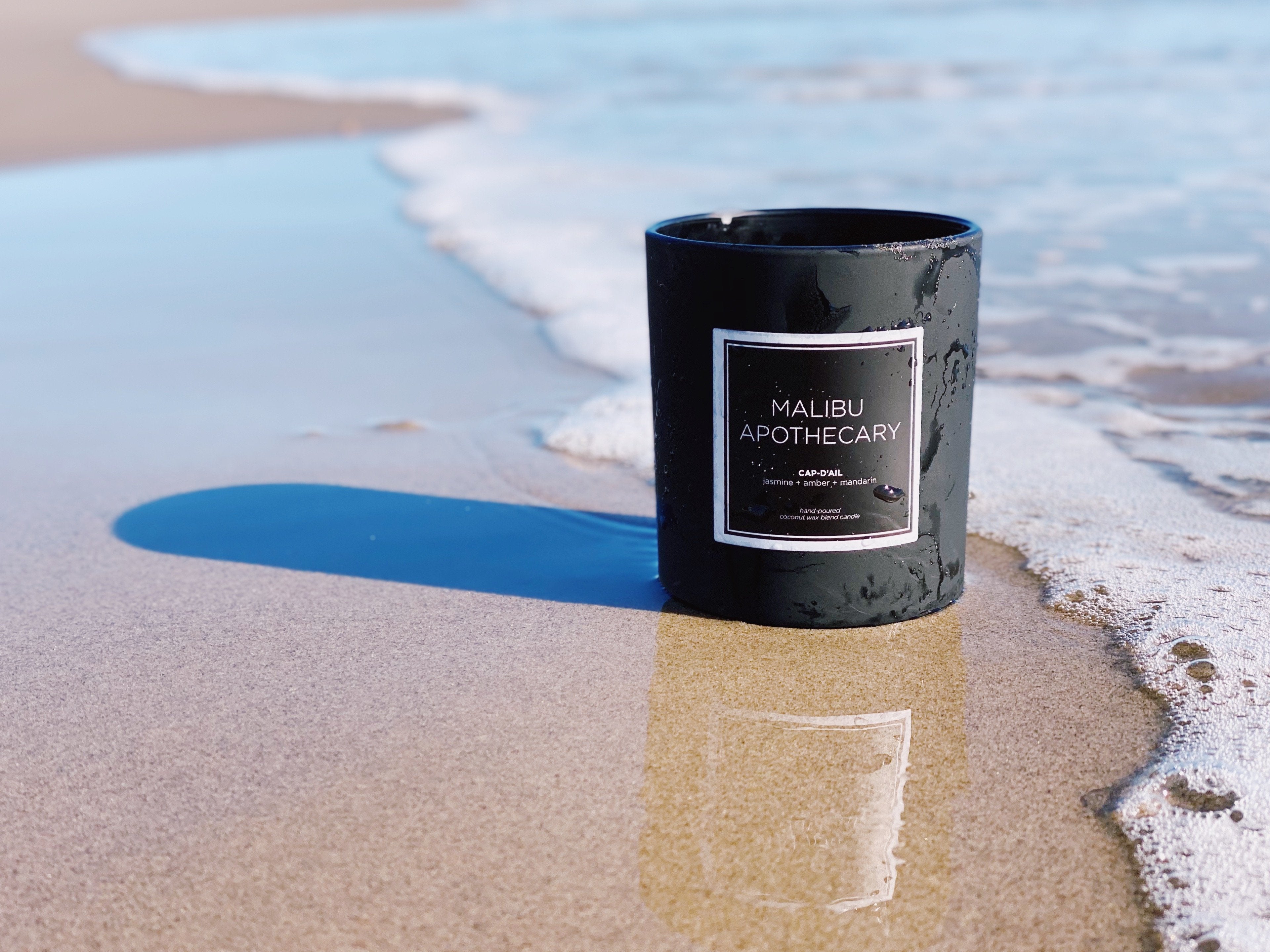MALIBU APOTHECARY | CLEAN CANDLES FOR A CLEANER EARTH
 When we say that we make clean candles for a cleaner earth, we don't say that lightly.
When we say that we make clean candles for a cleaner earth, we don't say that lightly.
Many brands out there have their own definition of "clean". Often times, they will not even tell you what that means.
Why are these "other" candles considered toxic?
Though most of us when we think of candles dream up images that are cozy and comforting, the reality is something very different. 95% of candles that are sold on the market today are actually toxic and harmful to our health. This is because they use wax that is made of paraffin, a petrochemical obtained from petroleum as a black sludge found on the bottom of oil barrels. In fact, ExxonMobil is one of the largest suppliers of candle wax today.1 Even asphalt is extracted in the refining process, before paraffin.
This toxic black sludge then undergoes further refinement and is whitened using bleaching agents that are 10x stronger than our household Clorox bleach. This process creates toxic dioxins, known to be carcinogenic. Several studies have shown that the dioxins from the bleach have an impact on human development, reproduction, and the immune system. It can also lead to cancer.
Most often, Paraffin wax is used to produce fragranced candles as it is the most economical wax and requires fewer machinery costs to process. This wax is claimed to be harmful due to the toxic fumes it releases when burned. In 2009, a study by South Carolina State University found that burning paraffin wax candles gives off harmful fumes such as toluene and benzene, which is linked to asthma and lung cancer.2
As a candle brand, you are not obliged to disclose the ingredients used. That is why many don't and when they do, they try to use terms like "high-quality paraffin wax" or mask it all together with synonyms such as "mineral wax" or "blended wax". The reality is though, most consumers don't even know it is harmful anyways.
Here are a list of a few common chemicals often present in paraffin wax:
- Trichloroethane
- Chlorobenzene
- Ethylbenzene
- Styrene
- Xylene
- Phenol
- Cresol
- Cyclopentene
- Acetone
- Trichlorofluoromethane
- Carbon Disulfide
- 2-Butanone
- Carbon Tetrachloride
- Tetrachloroethene
Our difference:
So, how is Malibu Apothecary changing status-quo? We are saying no to the more economical ways to create candles and opting for cleaner, and healthier options for you, your family, loved ones, friends, and your furry companions.
Our candles are made with all non-toxic ingredients, with names you can actually pronounce! To us, clean means using only coconut and soy wax, cotton wicks, and essential-oil infused fragrances. We never use parabens, sulfates, dyes, or paraffin. We also give back 20% of our sales (and probably our time, too) to coastal conservation initiatives such as Heal The Bay, for a cleaner earth. Now that is CLEAN!
SOURCES:
1 HTTPS://WWW.EXXONMOBIL.COM/EN/WAX/FULLY-REFINED-PARAFFIN-WAX
2 FREQUENT USE OF CERTAIN CANDLES PRODUCES UNWANTED CHEMICALS. (2009, AUGUST 24). RETRIEVED JUNE 4, 2018, FROM HTTPS://WWW.SCSU.EDU/NEWS_ARTICLE.ASPX?NEWS_ID=832
3 SIEGLE, L. (2011, NOVEMBER 27). THE BURNING ISSUE OF WAX. RETRIEVED JUNE 4, 2018, FROM HTTPS://WWW.THEGUARDIAN.COM/ENVIRONMENT/2011/NOV/27/LUCY-SIEGLE-CANDLE-WAX-ETHICAL
REFERENCES
BRITANNICA, T. E. (2018, MAY 09). PARAFFIN WAX. RETRIEVED JUNE 4, 2018, FROM HTTPS://WWW.BRITANNICA.COM/SCIENCE/PARAFFIN-WAX
THE WILDERNESS SOCIETY. (N.D.). SEVEN WAYS OIL AND GAS DRILLING IS BAD NEWS FOR THE ENVIRONMENT. RETRIEVED JUNE 4, 2018, FROM HTTPS://WILDERNESS.ORG/SEVEN-WAYS-OIL-AND-GAS-DRILLING-BAD-NEWS-ENVIRONMENT
HTTPS://PATHWAYSMV.ORG/THE-TRUTH-ABOUT-BEESWAX-CANDLES-2/#:~:TEXT=PARAFFIN%20WAX%20STARTS%20AS%20THE,CARCINOGENS%20BENZENE%20AND%2FOR%20TOLUENE.
HTTPS://FRAENDI.COM/BLOGS/BLOG/PARAFFIN-CANDLES-ARE-TOXIC
https://www.ncbi.nlm.nih.gov/books/NBK532257/
https://www.cdc.gov/niosh/npg/npgd0477.html
Read more

Based on the science that scent is the strongest trigger of memory, I started pouring candles as a hobby in my Southern California apartment. Here, I discovered the toxicity and unethical standards...

While this summer we may be spending a little more time at home, we came up with the best scented candles for summers enjoyed at home. Here are the top 4 candle scents for your best beach burn...

1 comment
Great idea…Great product. Congratulations…
Debra Connelly
Leave a comment
All comments are moderated before being published.
This site is protected by hCaptcha and the hCaptcha Privacy Policy and Terms of Service apply.